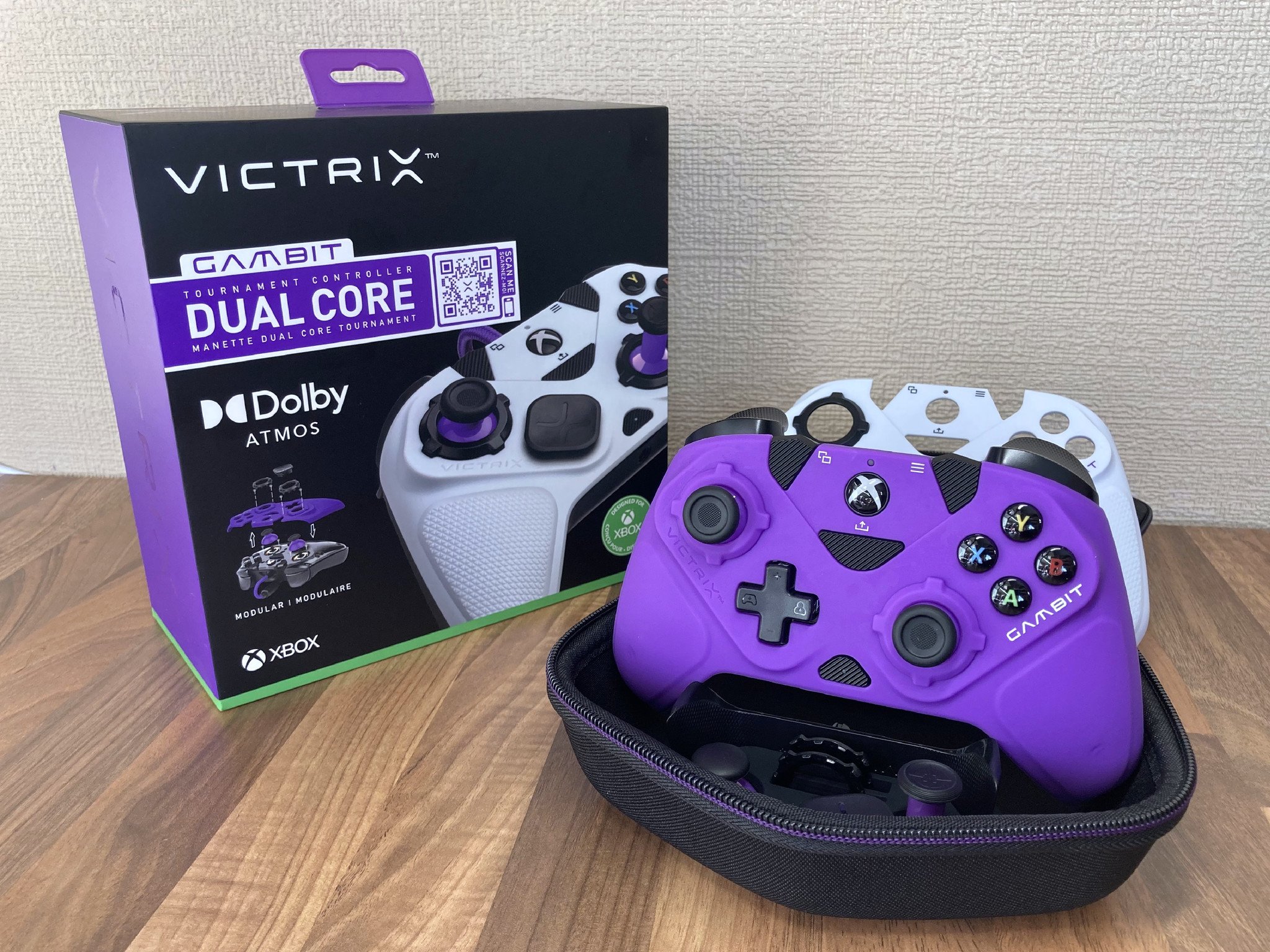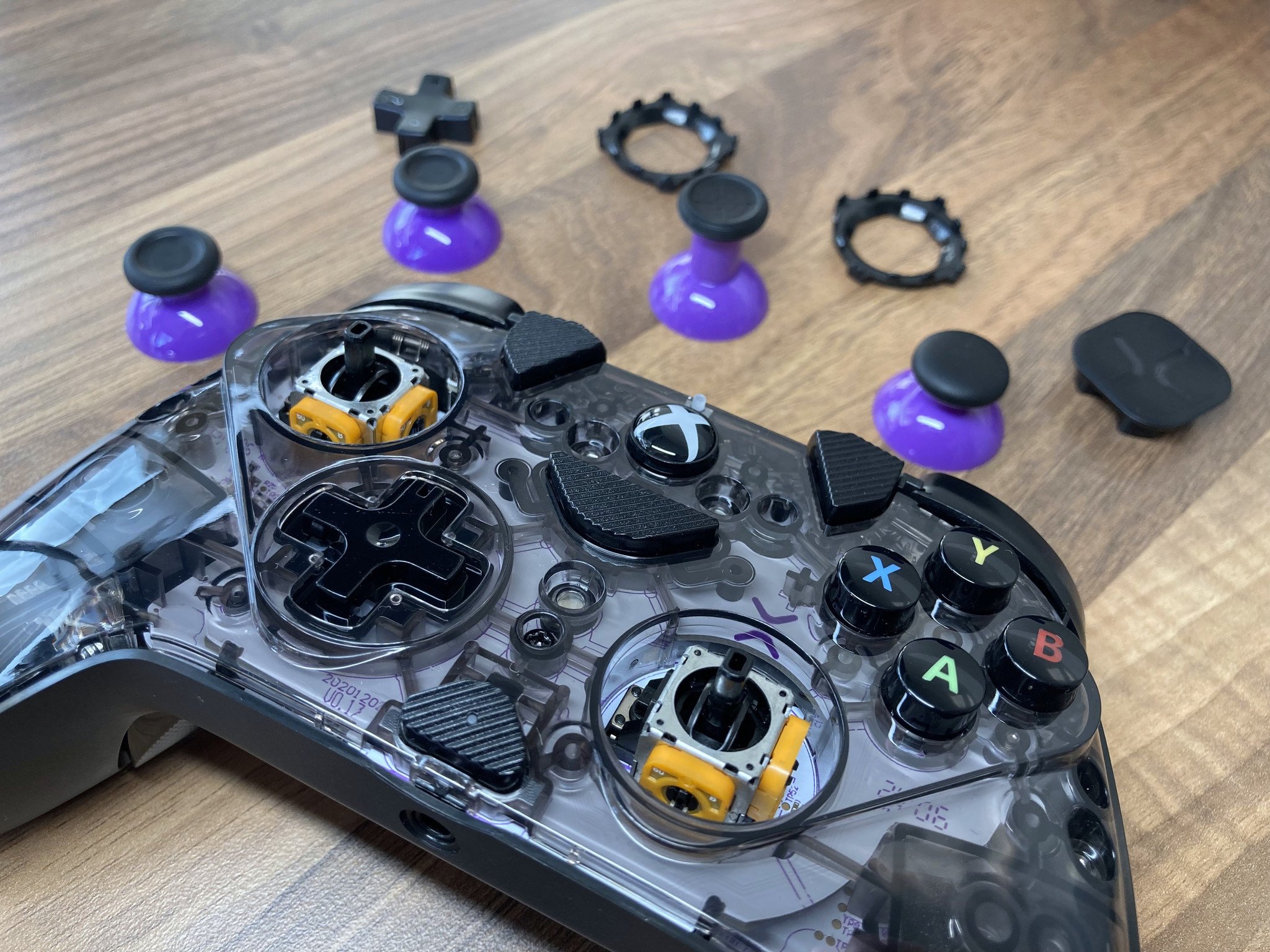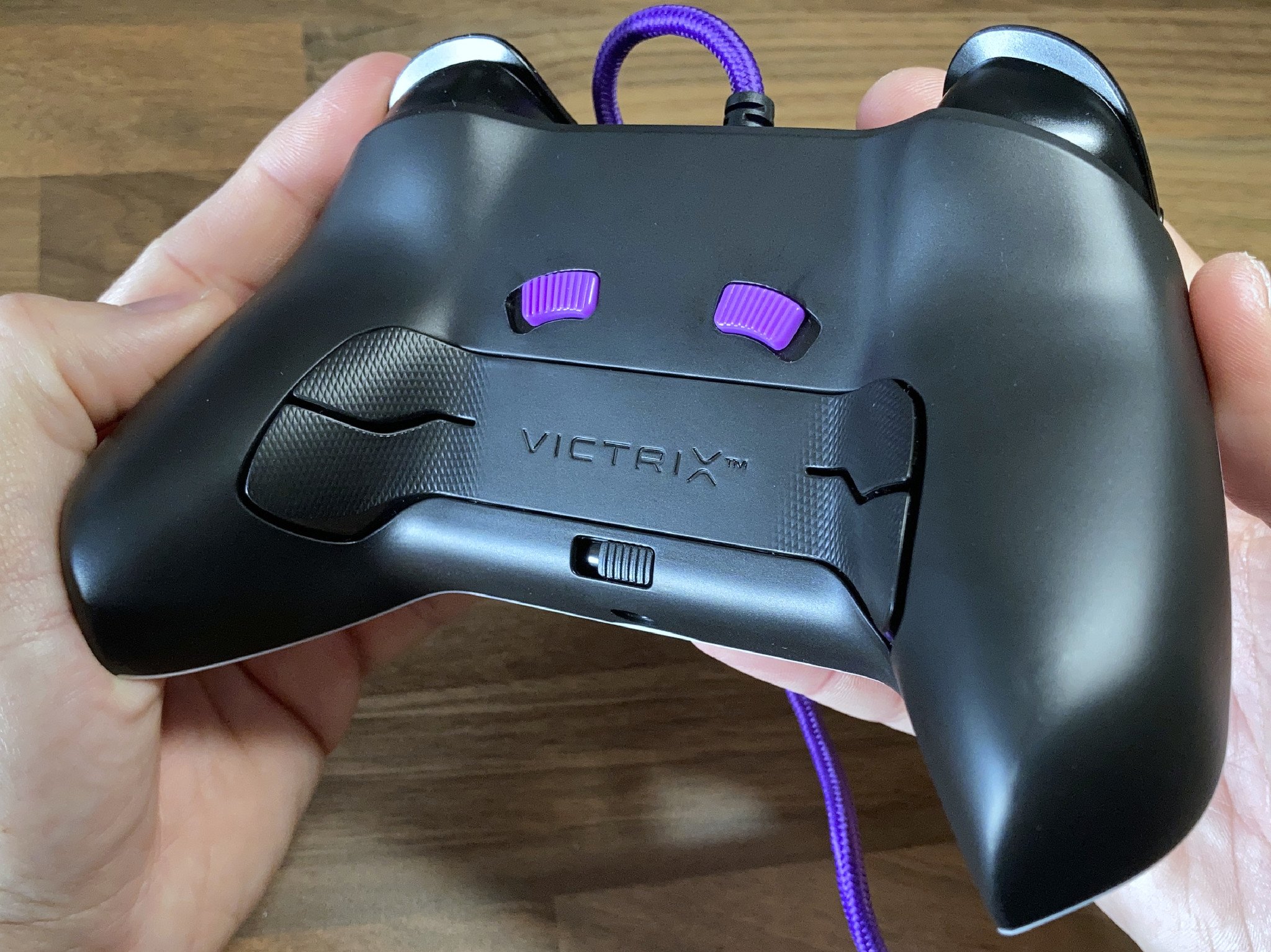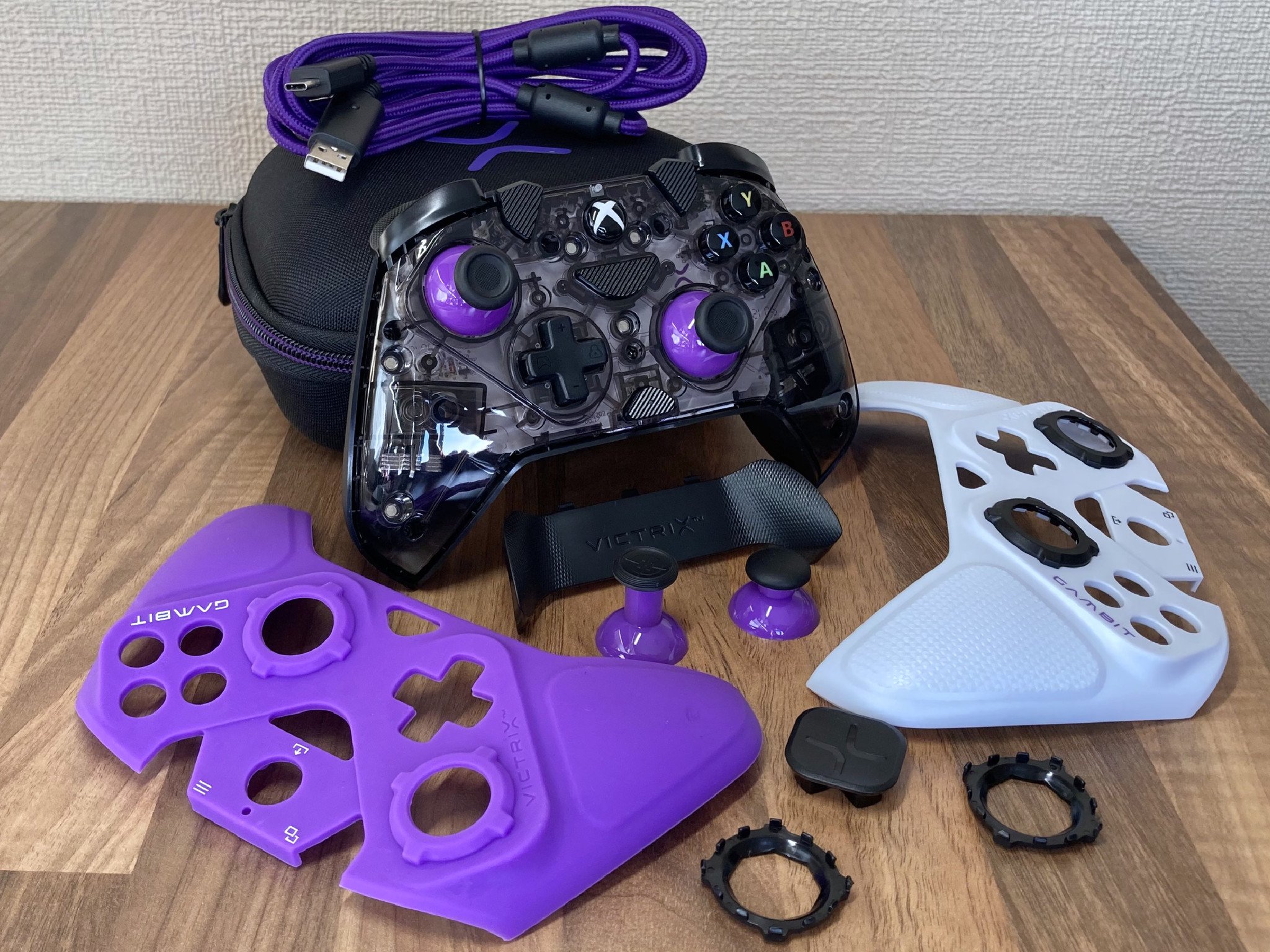
With a relatively modest range, I felt a certain level of skepticism about the quality of Victrix products. The California-based company was founded in 2015 to create gaming hardware for e-sports competitors. The Victrix Gambit fits that bill as their sole controller, designed for tournament-level play. Physically it resembles the Xbox Elite controller, complete with a share button. The dual-core processor inside uses one core for near-zero (2.1ms) input latency, and the other handles Dolby Atmos audio. The Gambit is compatible with Windows PC, Xbox Series X|S, and Xbox One.
Entering the third-party Xbox controller scene is tricky, with Corsair owning patents relating to wireless technology. Victrix pricing their controller cheaper than the Xbox Elite Series 2 seems attractive but losing that wireless freedom is a caveat that requires consideration. The Gambit advertises itself as the "world's fastest licensed Xbox controller." So if wireless isn't an option for Victrix, how does the Gambit compare to the best Xbox controllers in the game?

Bottom line: The Victrix Gambit is a formidable wired controller for Xbox and PC, with an impressive range for customization and accessibility. The downside is ultimately the lack of wirelessness and its disappointing trigger performance.
Pros
- Customizable components
- Back paddles give a competitive edge
- Long, heavy-duty USB cable
Cons
- No wireless
- Back paddles are too sensitive
- Weak trigger resistance
Victrix Gambit: Price and availability
Victrix sells the Gambit through its official store and major retailers, including Amazon, Best Buy, and Walmart. Enjoying good stock availability, the Gambit comes in one single configuration with white and purple colors.
Victrix Gambit: The positive

Initially confused as to why anyone would need so many interchangeable components for a controller, trying out each piece gradually convinced me. Having never dipped into the waters of e-sports gaming myself (ranked Halo: Infinite multiplayer is about as far as I might go), I didn't see the benefits right away. After spending a few days playing various games, I finally understood.
The Victrix Gambit is customizable in many ways, including four thumbsticks and gates (the round plastic surrounding the sticks). The Gambit is compatible with Xbox and PC with the Victrix Control Hub software available on both platforms, so I spent most of my time using it with my PC. The software allows you to calibrate the Gambit, adjust dead zones, and set custom audio profiles if you choose to connect headphones directly to the controller.
Not all PC games officially support controllers, often choosing to emulate keyboard input through the buttons and thumbsticks. Usually, this will work fine, but dead zones need a lot of adjustment to move the player in a straight line without wavering side to side. Using an octagonal thumbstick gate has a feeling much like my childhood Nintendo 64 did, restricting the analog movement to eight sharp directions. I found this much easier to control my movement in first-person shooter games, leaving the right thumbstick on a rounded gate for precision aiming.

The Gambit includes two magnetic faceplates swapped via an indentation on the bottom of the controller. The first plate is a white-colored plastic compatible with the thumbstick gates, which click into place from the rear. The other is a purple-colored "match silencer" rubberized plate, not compatible with any gates. Designed for improved grip and reduced noise, this rubber plate adheres to a rounded gate style. Both faceplates are comfortable, but the white plate is superior, still offering a textured grip around the palms and more customization options than the rubber alternative.
All the latest news, reviews, and guides for Windows and Xbox diehards.
On the plus side, the paddles helped immensely with accessibility.
Moving away from shooters, I tried out some fighting games where the diamond D-pad started to shine. The default D-pad is no different from the official Xbox controller, with eight directions of digital input. Since I never learned how to play fighters in the arcades, I honed my craft on the D-pads of home consoles and never felt comfortable on the sticks when inputting combos. The diamond D-pad on the Gambit has a rounded convex shape, comfortably sitting your thumb in the middle, making it easier to move between directions. Hitting the crucial quarter-circle rolling movements in fighting games felt super easy without over-shooting.

The rear of the Gambit features interchangeable back paddles, a choice of two or four paddles assigned using the "function" button at the front of the controller. A point of contention for me, the paddles felt simultaneously handy and frustrating, something we will get to later. On the plus side, the paddles helped immensely with accessibility. My partner has a genetic condition that restricts her finger movement, so binding the two back paddles to LB and RB meant she could keep two fingers permanently on the triggers. Having four paddles attached would undoubtedly be an advantage for competitive play, keeping all fingers firmly in place while accessing critical inputs.
Keeping the Gambit and its parts safe is the hard-shell "tournament carrying case" included in the box. Flaunting a gorgeous design, it serves a great purpose in neatly holding the tiny accessories and detachable USB-C cable. The Gambit carrying case design mirrors that of the Xbox Elite Series 2 but without the same charging dock functionality since it lacks wireless technology. Not exactly the fault of Victrix, including the case helps justify its price point and promote a premium feel to offset the reliance on its USB cable.
Victrix Gambit: The negative

We have to talk about the elephant in the room: the lack of wireless technology. Again, this is not the fault of Victrix since Corsair owns patents for wireless controllers and limits what other companies can do.
Though the included cable is lengthy (3m), it certainly has its downsides. If you live in a home similar to mine with rambunctious pets who see trailing cables as toys, then you might find disconnections are more frequent than you would like. The heavy-duty USB-C cable does lock fairly firmly into place, but being tied to the console still feels like a downside for the asking price.
In terms of practicality, the back paddles on the Gambit certainly have their uses. Unfortunately, I found myself too often pressing them by mistake whenever I held the controller in one hand. For actions like jumping and melee attacks in games, there were multiple times where I leaned on the paddles by accident. A reach for refreshments during stealthy sections in sneaking games had my character suddenly jumping for the ceiling or punching walls because the paddle rested too firmly into my palm.
Pulling each trigger feels like smooth plastic with barely any resistance.
The Gambit, admittedly, was designed for intense competitive gaming, so perhaps taking breaks was never in the design document. A flat panel replacing the back paddles would have been greatly appreciated, instead of having to choose between two paddles or four since I found them to be too sensitive to an unintended press. The Gambit is a cheap way of obtaining an Xbox controller with paddles, but if you have no intention of using them, you will find them more cumbersome than convenient.
The triggers might offer adjustable stop positions with the "clutch button" having five settings, but the springs are just too weak. Pulling each trigger feels like smooth plastic with barely any resistance, something a stronger spring could have fixed. For racing games, the triggers are too loose to control the pressure of your acceleration and braking. Better to stick to the shortest trigger stop if you plan to play shooters since the slightest pull counts as a shot.
Victrix Gambit: Should you buy it?

The Victrix Gambit is a refreshing change from the usual third-party bargain-basement controllers, offering solid and comfortable construction. With its calibration software available on both Xbox and PC, setting up the Gambit exactly how you want it is super easy. Its potential for customization is gigantic, and the support for Dolby Atmos extends its usefulness to some of the best headsets available.
You should buy this if ...
- You want a competitive edge in gaming
- Accessibility helps you play
You shouldn't buy this if ...
- You don't need extra back paddles
- Trailing cables would be an issue
There's no getting around the lack of wirelessness. As far as wired controllers go, the Gambit is a fantastic contender. Nonetheless, you should seriously consider how practical the individual components will be for you before splashing out on this $100 controller.
The Victrix Gambit serves best as a wired alternative to the Xbox Elite Series 2 controller or a cheaper version of the Razer Wolverine V2. Adjustable paddles, sticks, and triggers mean anyone looking for a competitive edge in gaming will benefit from the Gambit.

Bottom line: What the Victrix Gambit lacks in wirelessness, it makes up for with build quality and customization. The USB-C cable provides a latency so low that you can forgive its cable tethering you to the console or PC. Competitive gamers will have a field day with the components and back paddles, all for a reasonable price.

Ben is a Senior Editor at Windows Central, covering everything related to technology hardware and software. He regularly goes hands-on with the latest Windows laptops, components inside custom gaming desktops, and any accessory compatible with PC and Xbox. His lifelong obsession with dismantling gadgets to see how they work led him to pursue a career in tech-centric journalism after a decade of experience in electronics retail and tech support.

